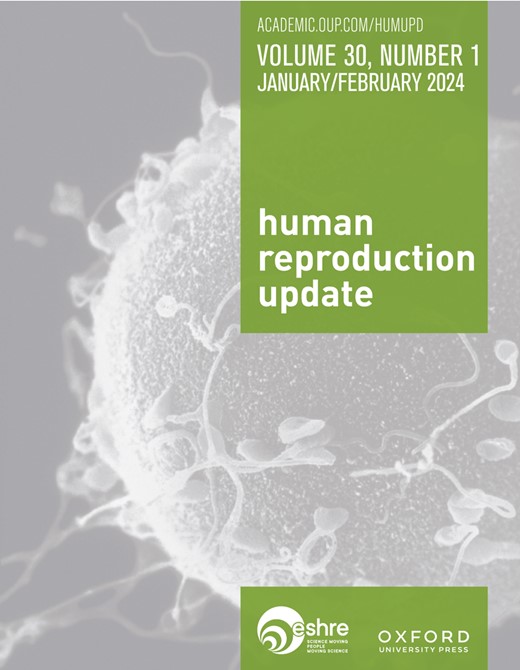Comparative efficacy of exercise, diet and/or pharmacological interventions on BMI, ovulation, and hormonal profile in reproductive-aged women with overweight or obesity: a systematic review and network meta-analysis.
IF 14.8
1区 医学
Q1 OBSTETRICS & GYNECOLOGY
引用次数: 0
Abstract
BACKGROUND The increasing prevalence of obesity worldwide poses a significant threat to reproductive function owing, in part, to hormonal disturbances caused by negative feedback between excess adiposity and the hypothalamic-pituitary-ovarian axis. Consequently, finding the most appropriate strategies to lose weight and improve ovulation in women with overweight or obesity is a clinically relevant matter that needs to be investigated. A comprehensive comparison of the independent and combined efficacy of lifestyle and/or pharmacological interventions on BMI, ovulation, and hormonal profile in women with overweight or obesity at risk of anovulatory infertility would facilitate improving fertility strategies in this population. OBJECTIVE AND RATIONALE This study aimed to evaluate the comparative efficacy of exercise, diet, and pharmacological interventions on BMI, ovulation, and hormonal profile in reproductive-aged women with overweight or obesity. SEARCH METHODS A systematic review was performed by searching PubMed, Scopus, Web of Science, PsycINFO, and Cochrane Library up to 14 December 2023, for randomized controlled trials assessing the effects of exercise, diet and/or pharmacological interventions (i.e. weight-lowering drugs or ovulation inducers) on BMI, ovulation, and/or hormonal profile in reproductive-aged women with overweight or obesity. We performed frequentist random-effect network meta-analyses and rated the certainty of the evidence. The primary outcomes were BMI and ovulation rate, and the secondary outcomes were serum reproductive hormone levels (gonadotrophins, androgens, or oestrogens). We performed sensitivity analyses, including the studies that only involved women with PCOS. OUTCOMES Among 1190 records screened, 148 full texts were assessed for eligibility resulting in 95 trials (9910 women), of which 53% presented a high or unclear risk of bias. The network meta-analyses revealed that, compared to control: diet combined with weight-lowering drugs (mean difference (MD) -2.61 kg/m2; 95% CI -3.04 to -2.19; τ2 = 0.22) and adding exercise (MD -2.35 kg/m2; 95% CI -2.81 to -1.89; τ2 = 0.22) led to the greatest decrease in BMI; exercise combined with diet and ovulation inducers (risk ratio (RR) 7.15; 95% CI 1.94-26.40; τ2 = 0.07) and exercise combined with diet and weight-lowering drugs (RR 4.80; 95% CI 1.67-13.84; τ2 = 0.07) produced the highest increase in ovulation rate; and exercise combined with diet and weight-lowering drugs was the most effective strategy in reducing testosterone levels (standardized mean difference (SMD) -2.91; 95% CI -4.07 to -1.74; τ2 = 2.25), the third most effective strategy in increasing sex hormone-binding globulin levels (SMD 2.37; 95% CI 0.99-3.76; τ2 = 2.48), and it was coupled with being ranked first in terms of free androgen index reduction (SMD -1.59; 95% CI -3.18 to 0.01; τ2 = 1.91). The surface under the cumulative ranking curve scores suggested that: diet combined with weight-lowering drugs is the strategy most likely (94%) to produce the highest BMI reduction; and exercise combined with diet and ovulation inducers is the strategy most likely (89%) to produce the highest ovulation rate improvement. The sensitivity analyses, which exclusively included studies involving women diagnosed with PCOS, were consistent with the results presented above. WIDER IMPLICATIONS Overall, the findings of this network meta-analysis indicate that the combination of exercise, diet, and pharmacological interventions is effective for weight loss, improving ovulation, and normalizing the androgen levels of women with overweight or obesity. Although higher quality studies are needed, these results support that the optimal treatment strategy for women with overweight or obesity wishing to conceive must consider exercise, diet, and pharmacological interventions during the shared decision-making process.运动、饮食和/或药物干预对超重或肥胖育龄妇女的体重指数、排卵和荷尔蒙状况的比较效果:系统综述和网络荟萃分析。
背景全世界肥胖症的发病率越来越高,对生殖功能构成了严重威胁,部分原因是过多的脂肪和下丘脑-垂体-卵巢轴之间的负反馈导致激素紊乱。因此,为超重或肥胖妇女找到最合适的减肥和改善排卵的策略是一个需要研究的临床相关问题。本研究旨在评估运动、饮食和药物干预对超重或肥胖育龄妇女的体重指数、排卵和激素水平的比较效果。检索方法通过检索PubMed、Scopus、Web of Science、PsycINFO和Cochrane图书馆(截至2023年12月14日),对评估运动、饮食和/或药物干预(即降体重药物或排卵诱导剂)对超重或肥胖育龄妇女的BMI、排卵和/或激素水平的影响的随机对照试验进行了系统综述。我们进行了频数随机效应网络荟萃分析,并对证据的确定性进行了评级。主要结果是体重指数和排卵率,次要结果是血清生殖激素水平(促性腺激素、雄激素或雌激素)。我们进行了敏感性分析,包括仅涉及多囊卵巢综合症女性的研究。结果在筛选出的 1190 条记录中,有 148 条全文通过了资格评估,最终得出 95 项试验(9910 名女性),其中 53% 的偏倚风险较高或不明确。网络荟萃分析表明,与对照组相比:饮食与降体重药物相结合(平均差 (MD) -2.61 kg/m2;95% CI -3.04 至 -2.19;τ2 = 0.22)和增加运动(MD -2.35 kg/m2;95% CI -2.81 至 -1.89 ;τ2 = 0.22)可使体重下降幅度最大。22)导致 BMI 下降幅度最大;运动结合饮食和排卵诱导剂(风险比 (RR) 7.15; 95% CI 1.94-26.40; τ2 = 0.07)以及运动结合饮食和降体重药物(RR 4.80; 95% CI 1.67-13.84; τ2 = 0.07)对排卵率的提高最高;运动结合饮食和减轻体重药物是降低睾酮水平最有效的策略(标准化平均差 (SMD) -2.91; 95% CI -4.07 to -1.74; τ2 = 2.25),在提高性激素结合球蛋白水平方面排名第三(SMD 2.37;95% CI 0.99-3.76;τ2 = 2.48),同时在降低游离雄激素指数方面排名第一(SMD -1.59;95% CI -3.18-0.01;τ2 = 1.91)。累积排名曲线下的表面得分表明:饮食与降低体重药物相结合是最有可能(94%)降低体重指数的策略;运动与饮食和排卵诱导剂相结合是最有可能(89%)提高排卵率的策略。总体而言,这项网络荟萃分析的结果表明,运动、饮食和药物干预相结合对超重或肥胖妇女减轻体重、改善排卵和使雄激素水平正常化是有效的。尽管还需要进行更高质量的研究,但这些结果支持在共同决策过程中,对希望怀孕的超重或肥胖女性的最佳治疗策略必须考虑运动、饮食和药物干预。
本文章由计算机程序翻译,如有差异,请以英文原文为准。
求助全文
约1分钟内获得全文
求助全文
来源期刊

Human Reproduction Update
医学-妇产科学
CiteScore
28.80
自引率
1.50%
发文量
38
期刊介绍:
Human Reproduction Update is the leading journal in its field, boasting a Journal Impact FactorTM of 13.3 and ranked first in Obstetrics & Gynecology and Reproductive Biology (Source: Journal Citation ReportsTM from Clarivate, 2023). It specializes in publishing comprehensive and systematic review articles covering various aspects of human reproductive physiology and medicine.
The journal prioritizes basic, transitional, and clinical topics related to reproduction, encompassing areas such as andrology, embryology, infertility, gynaecology, pregnancy, reproductive endocrinology, reproductive epidemiology, reproductive genetics, reproductive immunology, and reproductive oncology. Human Reproduction Update is published on behalf of the European Society of Human Reproduction and Embryology (ESHRE), maintaining the highest scientific and editorial standards.
 求助内容:
求助内容: 应助结果提醒方式:
应助结果提醒方式:


